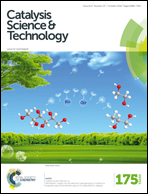Solubility product difference-guided synthesis of Co3O4–CeO2 core–shell catalysts for CO oxidation
Abstract
It is still an important issue to develop a facile, environmentally friendly way to synthesize bimetal oxide materials. In this paper, Co3O4–CeO2 core–shell catalysts were prepared by an interfacial reaction, where Co(CO3)0.35Cl0.2(OH)1.1 nanorods were dispersed in Ce3+ aqueous solution for 2 days, followed by a calcination step. The samples were characterized by X-ray diffraction (XRD), transmission electron microscopy (TEM), and X-ray photoelectron spectroscopy (XPS). Based on the characterization and comparative experimental results, we proposed that the OH− ions slowly dissociated from the Co(CO3)0.35Cl0.2(OH)1.1 precursor combined with Ce3+ to develop into Ce(OH)3 nanoparticles because of its smaller solubility product constant than that of the Co precursor or Co(OH)2. Neither an additional precipitation agent nor stabilizing molecules were employed during the whole preparation. Raman spectroscopy and H2-temperature programmed reduction (H2-TPR) analysis revealed that there is a synergistic effect between Co3O4 and CeO2 in the as-prepared Co3O4–CeO2 core–shell catalysts, which is responsible for their enhanced catalytic activity toward CO oxidation in comparison to pure Co3O4 and CeO2.


 Please wait while we load your content...
Please wait while we load your content...